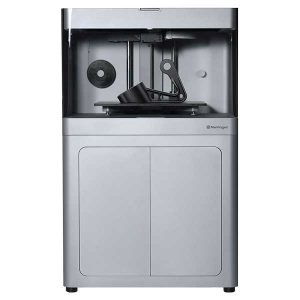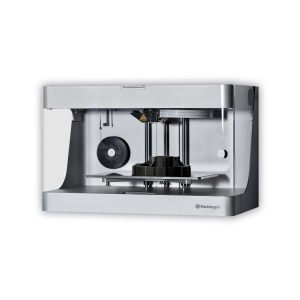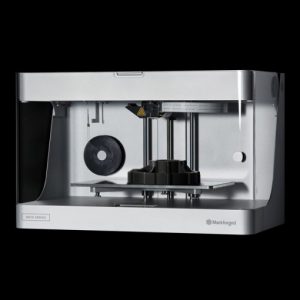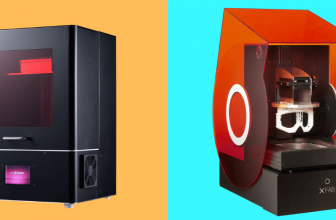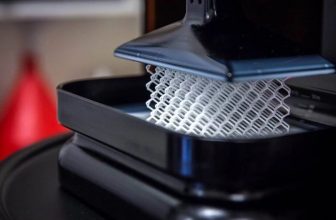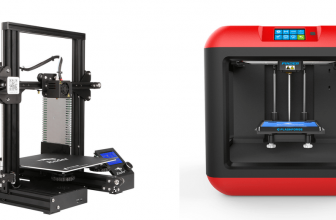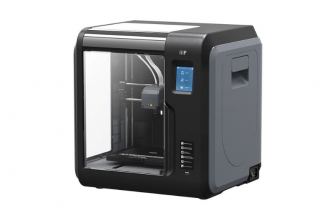This PA6 copolymer (polyamide) filament with a chopped carbon fiber blend adds strength and stiffness to FFF printing like no other. In comparison to other reinforced filaments on the market, the surface finish is a superb matte black color.
Onyx from MarkForged is a great material for customer-facing parts that need to look attractive while still holding up to rigorous industrial demands.
It is made of a specifically designed polyamide, yet it has a stiffness that is equivalent to or better than any pure thermoplastic material for professional 3D printers. It is simple to print and assemble, and it’s a lot more rigid.
Onyx and Continuous Carbon Fiber 3D Print
Onyx can be used alone or with integrated continuous carbon fiber, Kevlar, or fiberglass layers for further strength. It can also be used on its own to print objects with less stringent mechanical constraints. Onyx-printed parts warp significantly less than Nylon-printed parts.
Onyx has a flexural strength of 81 MPa and flexural stiffness of 2.9 GPA, making it 1.4 times stronger and stiffer than ABS. More properties can be found in the table at the bottom of this post.
How to Deal with Onyx
While the filament Onyx is an incredibly durable technical plastic that pairs CFF fiber materials from MarkForged, it is prone to moisture absorption.
Onyx that absorbs excessive moisture will result in unsuccessful prints, under-extrusion, holes in the roof of pieces, and other printing difficulties. Please take particular care not to expose Onyx to ambient air and to keep it in the Dry Box provided.
The company describes its printer as an industrial 3D printer with best-in-class software, as well as powerful sensors and hardware. The X7 comes equipped with a 3rd-generation fiber reinforcing system that allows you to lay down continuous fiber into pieces.
Comparison Chart
| Name | Link | Nomination | Rating |
|---|---|---|---|
| MarkForged X7 | Powerful | 10 | |
| MarkForged X5 | High Accuracy | 9.8 | |
| MarkForged X3 | Durability | 9.7 | |
| MarkForged Mark Two | Heftiness | 9.2 | |
| MarkForged Onyx Pro | High Quality Printing | 8.1 | |
| MarkForged Onyx One | Affordability | 8.3 |
Best Printers for ONYX
MarkForged X7
|
The company describes its printer as an industrial onyx 3D printer with best-in-class software, as well as powerful sensors and hardware.
The X7 comes equipped with a 3rd-generation fiber reinforcing system that allows you to lay down continuous fiber into pieces.
Uses:
- The machine is outfitted with hardware that is designed to fulfill each task with extreme precision.
- The MarkForged X7 also contains sensors that will guarantee that you are notified of everything you need to know.
- There is also the unique software that comes with the printer, which is both user-friendly and dependable.
- Micron-level laser scanning is another unique feature of the MarkForged X7 that is not present in any other 3D printer.
- Users of this printer, according to the business, may obtain industrial-grade parts in their hands in hours, not weeks.
- The MarkForged X7 is controlled by browser-based software that allows you to design your item, upload it, and then choose from a wide choice of composite and continuous fiber-based filaments for printing.
- The MarkForged X7 is a 3D printer that uses FFF technology and has a build volume of 330 mm * 270 mm * 200 mm.
- It is possible to print with a wide variety of materials.
- Massive build volume.
- To provide you with a flawless user experience, they have invested in cutting-edge hardware and software.
- Because of the printer’s confined print chamber, post-processing of the parts and working prototypes generated with it is challenging.
MarkForged X5
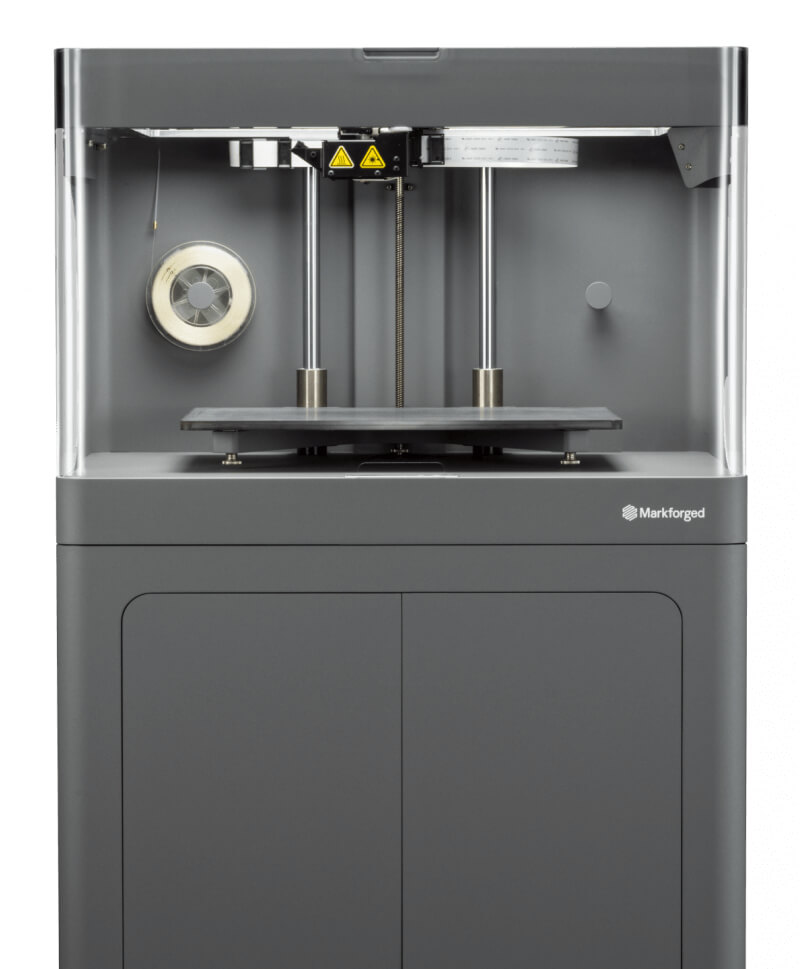
The manufacturer of this onyx 3D printer claims that the printer will produce prints that are stronger, lighter, and larger.
While both printers employ a normal filament printing technique, MarkForged’s unique thermoplastic fiber filament allows for the creation of sturdy, useable items. In fact, the X5 allows you to include a continuous strand of fiberglass in your 3D printing.
The final prints appear to have stronger mechanical qualities than aluminum, which is impressive (up to 20x). Parts printed using the X5 can be up to 23 times stronger than those printed with standard resins like ABS.
Uses:
- The X5 is powered by Onyx with exceptional material strength and stiffness that can be reinforced with a continuous fiberglass strand, making it 19X stronger and 10X stiffer than typical plastics.
- The MarkForged X5’s huge capacity makes it perfect for robots, automotive parts, working prototypes, and small batches.
- Your items will come out of the printer with a stunning surface quality that approximates the look and feel of injection molding with a layer height of 0.05mm.
- You can use your browser to load 3D print jobs from your PC into this printer’s cloud-based EIGER software. Controlling the 3D printer is possible via LAN cable, USB, and W-LAN. You can use the software to manage and catalog your STL files.
- The built-in touchscreen on MarkForged’s X5 3D printer makes it simple to control the wireless connection, start printing, and manage the printer.
- A wide range of materials can be used to print.
- Huge build volume.
- Post processing is difficult.
MarkForged X3
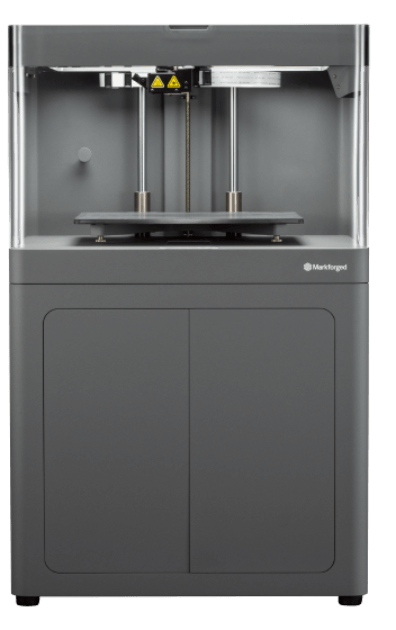
The MarkForged X3 onyx 3D printer is the most powerful on the market. The MarkForged X3 becomes an indispensable printer for every manufacturer thanks to the industrial pressure of incredibly strong parts and the first precision sensor systems.
The combination of double the strength of common standard plastics and a sophisticated sensor unit provides unrivaled reliability. The MarkForged X3 allows you to turn any design concept into a reality.
Uses:
- The X3 3D printer produces printed parts with unrivaled strength, rigidity, and durability.
- The X3’s material usage detection notifies material usage and alerts users when the filament is about to run out.
- The 3D printer scans the print bed with a built-in laser to provide accurate bed leveling and high-precision calibration. In addition, the laser acts as a fail-safe in the event of a power outage by scanning and determining where the 3D print stopped.
- The 4.3-inch touchscreen allows for a user-friendly interface.
- Elger proprietary software is supported, allowing users to 3D print from their browser and manage their fleet of 3D printers.
- Huge build volume
- Good printing quality
- Flawless user experience
- Post processing is difficult
MarkForged Mark 2
|
The Mark 2 by MarkForged is an industrial onyx 3D printer with a plethora of excellent features, making it one of our top recommendations.
Whether you are a 3D printing enthusiast or work in an industry that could benefit from the technology, the Mark 2 is an excellent choice for either application, and it can last for several years before being replaced by the updated model.
Mark 2 is a highly recommended onyx 3D printer for mass production that offers build volume versatility.
Uses:
- It employs carbon fiber reinforcement technology to construct objects with greater tensile strength and durability, and it has a build volume of 320 mm * 132 mm * 154 mm, allowing for a large printing area.
- Mark 2 is well known for printing high-temperature glass fiber and Kevlar, but it can also be used to create a variety of other wonderful and long-lasting objects.
- It can also print at a layer resolution of 100 microns, which is quite impressive.
- It also includes its own software, dubbed ‘Eiger’. You can easily import and slice designs intended for high-performance production of parts and prototypes using Eiger. As a result, the Mark 2 is an industrial-grade 3D printer capable of mass production.
- It can be used in a variety of industries, including automotive, aerospace, dentistry, jewelry, and defense. According to MarkForged, this is a powerhouse with “workhorse reliability,” which means you can use it to create multiple objects and items for the entire day and it will not fail you.
- Is equipped with specialized software for importing and slicing designs.
- Suitable for continuous operation throughout the day without overheating.
- It has the potential to be used in mass production.
- Manual calibration is required.
- It is unaffordable for domestic use due to the high price.
MarkForged Onyx Pro
|
MarkForged’s machines generally perform well, and the Onyx Pro is yet another example of how the company has used its knowledge and experience to create a 3D printer at a much lower cost.
If you are looking for a machine that can print high-performance parts and functional prototypes, you will not find a better option than this one.
Uses:
- Onyx Pro is a high-end professional 3D printer that uses Continuous Fiber Reinforcement 3D printing to create parts and functional prototypes.
- The printer is built on an aluminum unibody frame, which provides high accuracy and repeatability.
- This machine is designed to be simple to operate and maintain.
- Onyx Pro can print precise parts with the best surface finish in the industry.
- This 3D printer’s maximum build volume is 320 mm * 132 mm * 154 mm, and the machine’s overall dimensions are 575 mm * 322 mm * 360 mm.
- It weighs 13 kilograms and prints parts and functional prototypes with layer resolutions ranging from 0.1 mm to 0.2 mm.
- The printer can be accessed via both Wi-Fi and USB. A web-based process can be used to monitor this 3D printer.
- This printer’s extrusion system includes a second-generation extruder with out-of-plastic detection.
- Capable of producing parts and functional prototypes ten times stronger than standard 3D printing materials
- The layer resolution range is excellent.
- The body is stable.
- The software is extremely user-friendly.
- The cost of 3D printing materials compatible with this 3D printer is significantly higher than the cost of mainstream FDM 3D printing materials.
MarkForged Onyx One
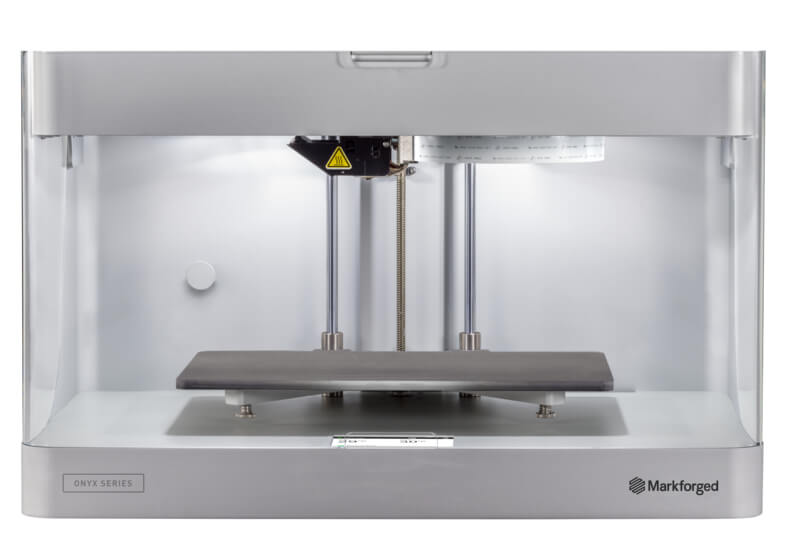
MarkForged’s entry-level model is the Onyx One. In no time, you can print beautiful, sturdy carbon components on your desk.
With the ideal overall package – hardware, software, and materials – the Onyx One provides a one-of-a-kind 3D printing experience that will enthrall everyone.
Uses:
- The Onyx One has a printhead that is specifically designed to print Onyx components.
- The MarkForged Onyx material is a black filament made from tough nylon and micro-carbon reinforcement.
- Scalability is another appealing feature of the new Onyx One 3D printer.
- The Onyx 3D printed parts have a high-quality surface finish as well as a high heat tolerance.
- The MarkForged Onyx One comes with MarkForged Eiger software, which is powerful and simple to use. Eiger enables accurate control of the 3D printing process.
- Offers large build volume
- Printed parts with high-quality surface
- Excellent software
- High material cost
Buying Guide
Before purchasing an onyx 3D printer, it is a good idea to determine which features are essential. So far, we have gone over a few of the most important features. These printer features will make your 3D printing experience more enjoyable!
If you follow the steps outlined below, your hard-earned money will not be squandered. Check them twice to avoid turning the exciting 3D adventure into a disaster.
Printing Quality
Any 3D printer manufacturer wants their machines to produce the highest-quality prints possible. Disparities in performance are frequently the result of technology and budget decisions.
It is difficult to incorporate all of the latest features while staying within a limited budget. 3D printer kits, on the other hand, allow you to save money on print costs while still getting a competitive 3D printing system.
Company Support
In addition to all technological requirements, the company’s support is critical. Users can also learn about the company’s customer service. Anything must be included for the printer’s evaluation.
Even if it is the best on the market, it is backed by a warranty and offers onsite and remote support. Any computer has the potential to fail at any time. Failure to provide technical assistance would result in money being squandered.
Speed and Volume
If you value speed and volume, look for a printer that can produce a smooth finish. It does not require any post-production. If you want to print multiple parts at once, choose a printer with a large build volume.
Reliability
Reliability is something that every consumer wants, whether the design is open-source or not.
What if the 3D printer works for a few days before failing to function properly? What if your 3D printer occasionally malfunctions? It is also untrustworthy if the results are not consistent and reliable.
So, keep an eye out for it and participate in online communities. This will help you learn more about the popularity of 3D printers in terms of dependability.
Safety Features
3D printers are designed with numerous safety features to ensure the effectiveness of the printing process and the machine’s efficiency.
After the printing process is finished, FDM 3D printers typically cool the nozzle and heated bed. To avoid heat damage or excess filament, some 3D printers move the nozzle away after the job is paused or completed.
Heated Bed
Another optional feature that is not required to get started with 3D printing is a heated bed. It does, however, play an important role in increasing the bonding power of the initial layer. It keeps the print’s bottom warm, allowing the printed model to be formed without warping.
Frequently asked questions FAQs
What is the objective of 3D printing?
Everything from a frame for your drone project to a door stopper and everything in between can be 3D printed.
On the industrial side, 3D printing has enabled various industries, ranging from healthcare to automotive, to do previously impossible things and bring goods to market much faster.
The medical field is one impressive application of 3D printing. Custom-made prostheses and 3D printed tissue are becoming more popular in laboratories.
In contrast, 3D printing excels at producing small quantities of products.
What is the largest 3D printed part with an onyx 3D printer?
The build volume of the desktop printers (Onyx One, Onyx Pro, and Mark Two) is 320 mm x 132 mm x 154 mm, while the build volume of our industrial printers (X3, X5, and X7) is 330 mm x 270 mm x 200 mm.
Users of the Metal X can print parts up to 250 mm x 220 mm x 200 mm (or 9.8 in x 8.6 in x 7.9 in). The printed part, however, will be larger than the usable, sintered part because the parts shrink during sintering.
Your part will be automatically scaled in the Eiger software to fit in the sinter, which measures 235 mm x 68.3 mm x 69.3 mm (or 9.25 in x 2.69 in x 2.73 in).
What 3D printing technology does Markforged Onyx employs?
The FFF (Fused Filament Fabrication) technology used by the Onyx One and X3 is the most well-known and widely used 3D printing technology.
Thermoplastic material is heated and extruded through a nozzle before being deposited layer by layer on the print bed until the model is complete.
CFF (Continuous Filament Fabrication) technology is used in the Onyx Pro, Mark Two, X5, and X7 printers, where a second nozzle is used to lay continuous strands of composite fibers (such as carbon fiber) within FFF-extruded thermoplastics while printing. The continuous fibers strengthen and stiffen the printed part.
ADAM (Atomic Diffusion Additive Manufacturing) technology, which is based on FFF technology, is used in Metal X printers.
Metal powder is encased in a plastic binder before being deposited layer by layer by an extruder — this safe and accessible process eliminates the need for hazmat suits or stringent facility requirements.
The part is then washed and sintered to dissolve the binder and allow the metal powders to fuse.
Conclusion
This concludes our buyer’s guide to the best onyx 3D printers available. Our top picks are extremely affordable and can be used for industrial-level printing with ease.
Whatever onyx 3D printer you choose to meet your printing needs, make sure to weigh it against the factors listed above.
They will assist you in making an informed decision and selecting a 3D printer that not only produces high-quality prints but also has a variety of useful features and value-added options.

